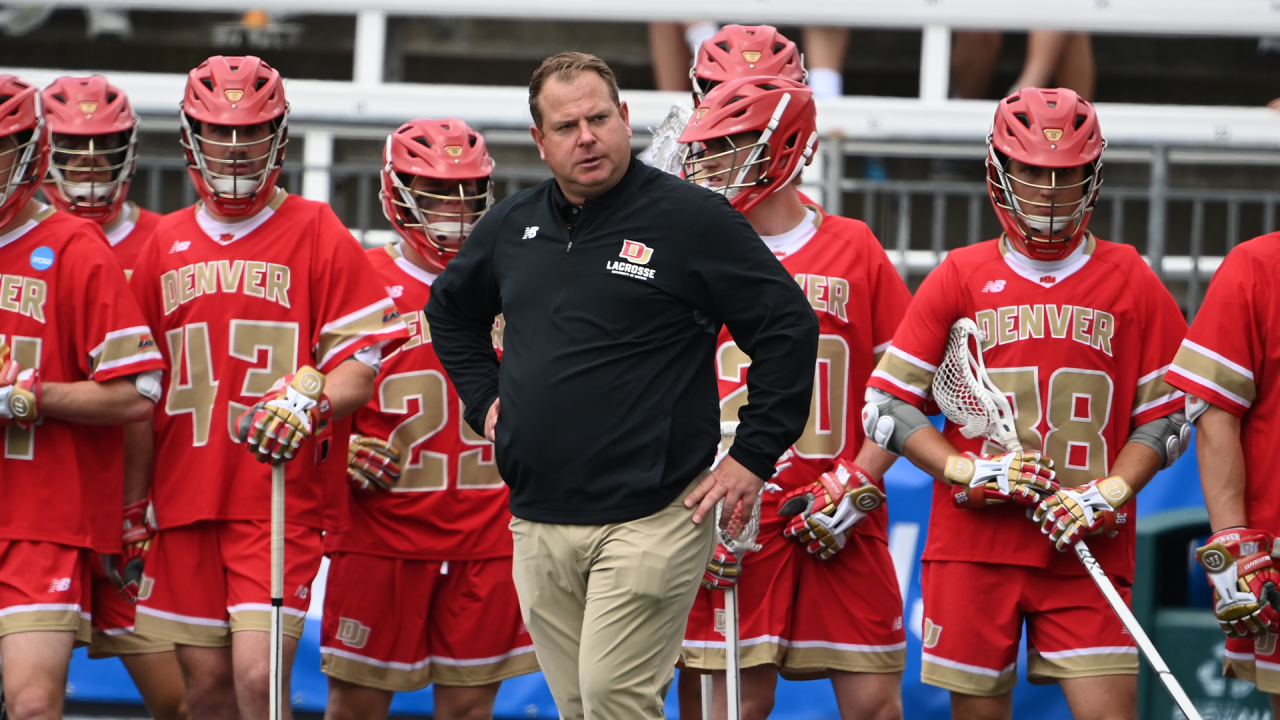DAZZLING DEBUT
Matt Brown brought some head coaching experience into his first year in charge at Denver — after all, the man was Team Canada’s coach in the World Lacrosse Men’s Championship last summer. But for the purposes of college coaching, he’s a first timer.
Which puts the Pioneers’ leader in select company after Denver’s 10-8 defeat of Syracuse in Sunday’s quarterfinals.
Brown joins Dave Klarmann (1991 North Carolina), John Desko (1999 Syracuse) and Connor Buczek (2022 Cornell) as the only first-time head coaches to lead programs to the NCAA semifinals since the Championship Weekend era was established in 1986. Notably, all four were assistant coaches at their respective schools who were promoted from within.
Only two first-time coaches in the tournament’s first 52 editions led their teams to titles in their debut seasons: Klarmann and Johns Hopkins’ Don Zimmerman, who debuted with back-to-back titles in 1984-85 after previously serving as a Blue Jays assistant.
TEWAARATON WATCH
A look at how four Tewaaraton Award finalists playing this weekend fared …
Liam Entenmann, G, Notre Dame. Had eight saves and 10 goals allowed against Georgetown, but much of the damage was done long after the result was decided. After three quarters, Entenmann had six saves and four goals allowed. He’ll take a .551 save percentage and 9.39 goals-against average into the NCAA semifinals.
Pat Kavanagh, A, Notre Dame. Back home on Long Island, the graduate student had three goals and an assist on four shots. He now has 28 goals and 41 assists on the season.
Brennan O’Neill, A, Duke. The senior had a hat trick in his final college game, including a spectacular individual play with 6:32 left to briefly tie the Blue Devils and Maryland at 11. He concluded his last season at Duke with 54 goals and 27 assists.
Connor Shellenberger, A, Virginia. Fired in his first career overtime winner as part of a three-goal, one-assist effort in the Cavaliers’ defeat of Johns Hopkins. He’s up to 31 goals and 51 assists this year.
THIS WEEK’S ATTENDANCE MATTERS
Quarterfinal hosts Hofstra and Towson drew announced crowds of more than 9,000, the first time since 2017 that both quarterfinal sites did so.
Hofstra announced 9,086 for the Georgetown-Notre Dame and Duke-Maryland games on Saturday, while Towson — blessed with a participant playing a few miles from its campus — got 9,642 for Denver-Syracuse and Johns Hopkins-Virginia.
It’s the seventh time since the NCAA went to predetermined quarterfinal sites in 1996 that both crowds surpassed 9,000. The others were 2001 (Hofstra/Maryland), 2009 (Hofstra/Navy), 2011 (Hofstra/Foxborough, Mass.), 2012 (Navy/Chester, Pa.), 2015 (Denver’s Invesco Field/Navy) and 2017 (Hofstra/Delaware).
It should come as no surprise that Hofstra and Navy — two schools that combine geographical advantages for drawing a crowd with excellence at administering every facet of an NCAA quarterfinal — are scattered all over that list. Towson, too, deserves credit for smoothly handling its first quarterfinal since 2006 (though it is plenty experienced with May lacrosse, having hosted several women’s final fours since then).
FOUR GAMES, EIGHT STARS
Jack DiBenedetto, D, Denver. While the Pioneers pride themselves on team defense and not obsessing too much over individual matchups, DiBenedetto spent a good chunk of Sunday afternoon marking Syracuse’s Joey Spallina, who was held without a point and didn’t even take a shot until 8:33 remained.
Chris Kavanagh, A, Notre Dame. The junior set a school record with eight points in an NCAA tournament game, delivering five goals and three assists to send the Fighting Irish to Championship Weekend for the seventh time.
Michael Lampert, A, Denver. The senior assisted on the goal that started the Pioneers’ five-goal run just before halftime, and he barely beat the shot clock for the last score in the spurt late in the third quarter. He was one of four Denver players to score twice against Syracuse.
McCabe Millon, A, Virginia. The Cavaliers leaned on the freshman more than in recent weeks, and he delivered three goals and three assists — his largest point total since collecting seven against Robert Morris on March 5.
Marco Napolitano, D, Notre Dame. Part of an exceptional defensive unit that held Georgetown to four goals in the first three quarters, the graduate student also scored his first career goal with a 45-yarder into an empty net with 9:15 to play.
Ben Wayer, LSM, Virginia. The junior scooped up 10 ground balls and collected an assist on a transition goal in the fourth quarter to help the Cavaliers slip past Johns Hopkins.
Luke Wierman, FO, Maryland. The Terrapins dominated possession against Duke thanks to Wierman, who won 20 of 29 draws and has claimed 40 of 55 in two NCAA tournament games.
Ajax Zappitello, D, Maryland. The senior shadowed Duke’s Josh Zawada, helping to limit the graduate student to an assist and just one shot in the Terps’ upset victory.



























































